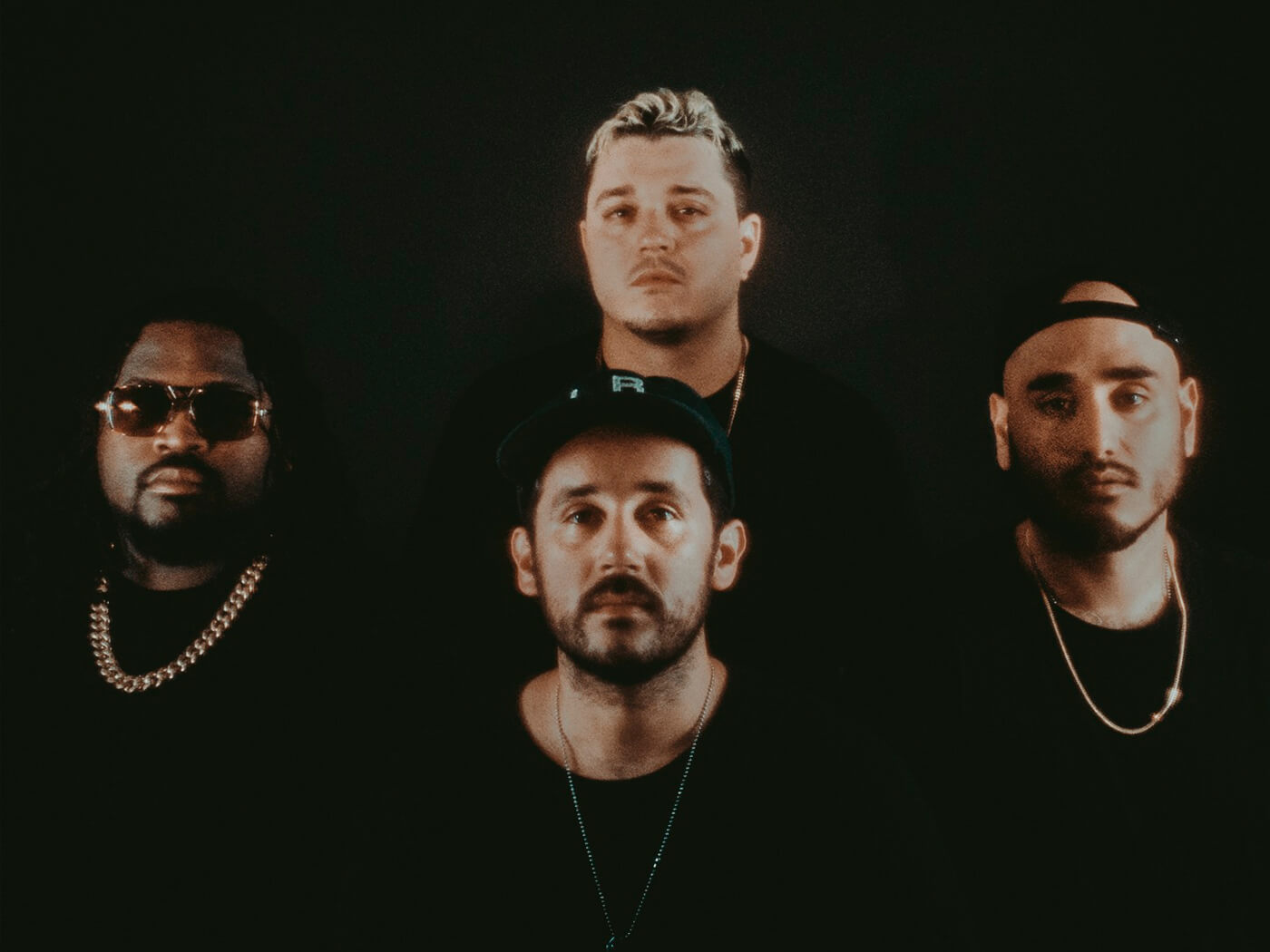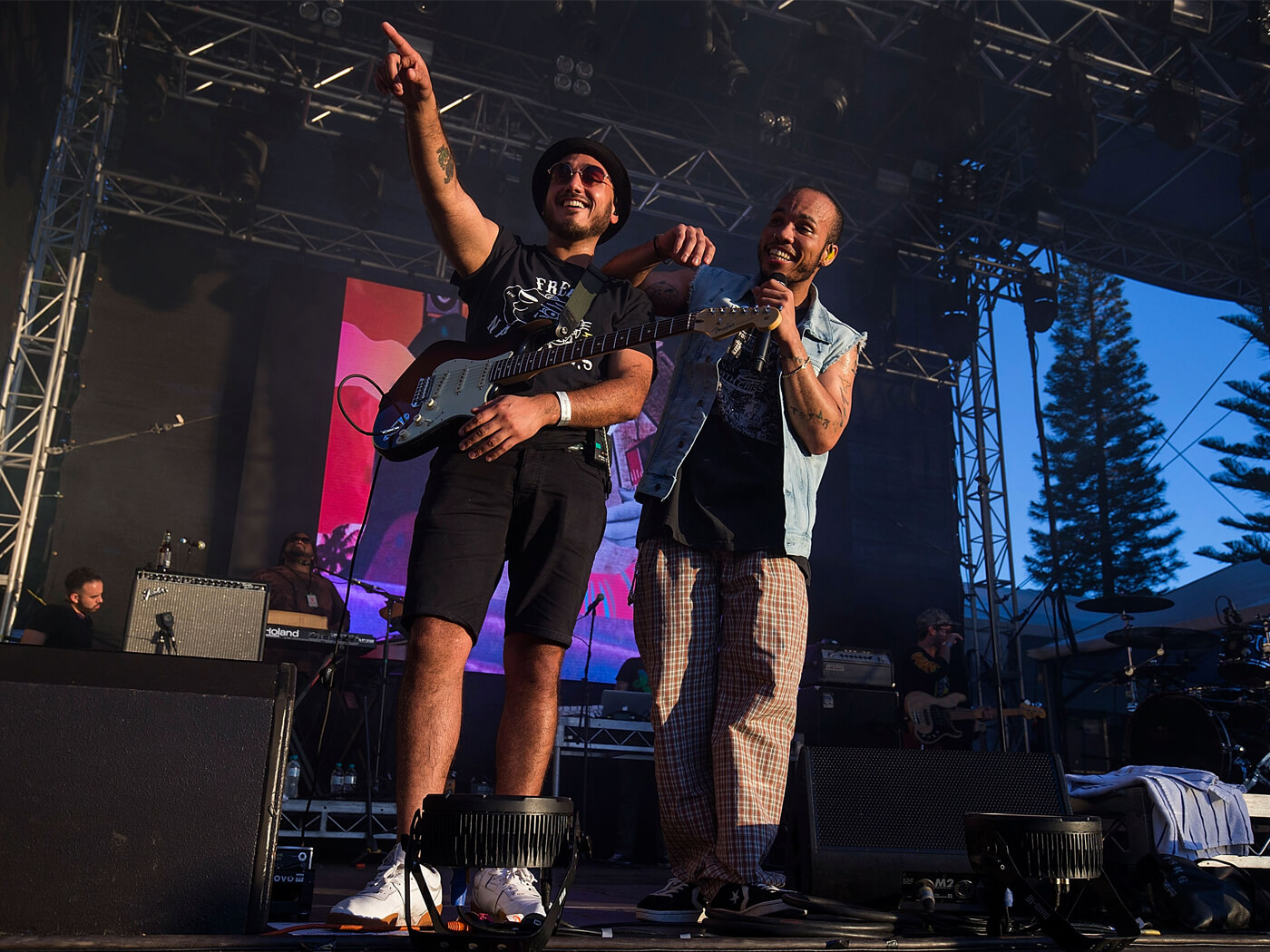Related Tags
Anderson .Paak’s backing band, the Free Nationals, take the spotlight with their debut album
Guitarist Jose Rios talks the recording process, his love of analogue, his extensive pedalboard and more.

Image: Press
Free Nationals, best known as the backing band for Grammy award-winning rapper Anderson .Paak, released their long-awaited self-titled debut album this month. The release features a star-studded list of guest vocalists and rappers from the worlds of rap, pop and R&B (most notably .Paak himself and the dearly departed Pittsburgh rapper Mac Miller). But make no mistake – the album is the Free Nationals’ showcase, and guitarist Jose Rios, keyboardist Ron Tnava Avant, bassist Kelsey Gonzales and drummer Callum Connor stand tall on this record.
The band’s signature 70s soul sound shines throughout the LP’s 13 tracks, their love of analogue popping through the crisp, jam-style sessions. While these easy-going textures and silky tones evoke a conscious homage to the giants of funk and soul, Free Nationals still manage to carve out their own sonic world. After almost a year on the road with .Paak, 34-year-old Rios hopped on the phone with Guitar.com to talk about his love of pedals, the influence of Stevie Ray Vaughan and how the Free Nationals cut most of the record in just ten days.
How did your relationship with the guitar begin?
Man, I’ll always remember the day that I wanted to play guitar because I was in the car with my father. I was about 15 and he was taking me home from school and I remember hearing Stevie Ray Vaughn play a song called Soul To Soul. He was just ripping the whole time on a Wah pedal and some distortion with a Strat and he was just terrorising the track, I had never heard anything like that before. As soon as I heard that, I became a student, I became a person who was searching out sounds and searching out more guitarists. Blues and soul was what I wanted to play.
Were you always influenced by soul and funk styles?
It was always soul and R&B. I just liked to hear the guitar sing and sound pretty; I wasn’t really into heavy metal or rock at the time at first. I got into that too but I really liked the way the guitar could sing and the pretty aspect to it, how it could be so melodic and the way you could present chords was interesting to me first. I didn’t think of it as an aggressive instrument.
https://www.instagram.com/p/Bsz44XfFX0e/?utm_source=ig_web_copy_link
How did the Free Nationals begin?
It’s all by chance. Mostly like everything that’s been meaningful or important in my life has all been by chance, it was just a natural occurrence. I met Anderson [.Paak] and Ron [Avant] at Musicians Institute in Hollywood. I just connected with them. We were together and we’ve come all this way together and we’ve always been friends no matter what. I keep Anderson and Ron very close to my heart, those are the first guys I ever played with in a band situation in Los Angeles. It was my first real band and we’re still a band.

Tell me about the decision to make the album.
Making a record was an idea that was pushed out there by Anderson, our agent and at the time, his manager. They were encouraging us. We were having fun doing all these tours with Anderson and we had helped out with the production of his albums and they just said, “What if you guys put out your own record and see what that’s like?” We thought it made sense but we’ve been so busy, we didn’t even think of doing it.
It was a lightbulb moment, doing this album. So we started chipping away at it; we did a week and a half in the studio and we cut what would be most of this record. Even Kali Uchis recorded her verse in that time period – she was the first artist on it. Once the music was done, it was all about throwing the right vocals on it. We wanted it to be our record y’know, we only wanted to have Anderson on it one time, just to show that we could do stuff with other people.
Was it important to you to have a certain sound for the guitar?
I wasn’t really thinking about making it sound a certain way. I used Fender American Pro series Tele that was gifted to me by Fender. I used a Vox amp on some of it, some of it I plugged directly in. I used an American Pro series Stratocaster and there was some acoustic guitar in one of the tracks, that acoustic guitar was a Martin guitar that our producer had. Really, it was just using the instruments I had around me.
We searched around for tones. In the beginning, I just had my pedalboard so I was using what was on that, which was a Dunlop Wah pedal, MXR chorus, MXR Phase 90, MXR Super Badass Distortion and MXR Reverb. I used that for those first sessions and then towards the end when we started doing overdubs, I used a Kemper amp that Callum had in his studio. It’s basically a big effects unit and we just dug through that looking for sounds, trying to find the right tone for the songs. It wasn’t fully how I wanted to do it because I didn’t have all the resources available to me but I used what I could, that’s how it’s always been. Ideally in the future, I want five or six amps, I want vintage guitars, I want analogue pedals and I just want to sit there and create tones in a room and record it all live with the microphone.
Was there any part of the process that sticks out to you?
Time, the Kali Uchis/Mac Miller song – I sat there for a while working on the tone with the Kemper. We had a Strat and we just wanted it to really cut through so we were digging through all these different clean sounds and then we added some chorus. We were fine-tuning it and you can hear on that guitar there’s some really crispy, clean little lines in there. Then there’s also the original recording of the first session that’s in there too, where I’m doing a Wah pedal and at the end, there’s an outro that’s still the original guitar that I used. That session is very built up, guitar-wise. I sat there and did a lot of layers and really searched for tone on that one. It has a lot of pretty parts.
Was it intentional to have only one instrumental track in Lester Diamond?
We had a couple more – we had a straight, punk rock, in-your-face one. It was crazy, I don’t know where it came from! [Lester Diamond] wasn’t intentionally instrumental, we just didn’t get anyone on it. That one was done early on and it was kind of empty at first. I think I was just strumming some chords in the first version but then at the very end, like two days before it was supposed to be pressed and put out, I went to the studio and I added some more guitar parts. I added a little melodic pick line in the beginning and I added this other melody towards the end and then I added a clean, chorus-y solo at the very end. None of that was there in the original version.
What’s your live setup like now?
I would say the most important pedal I have is my volume pedal. I use it for swells and it makes my guitar sound like a violin, because I push down on it while I’m hitting the note and even with the chorus and reverb and delay, you can really sound so beautiful, like an orchestra when you play chords. Of course, my BOSS tuner is a must. Then there’s my Dunlop Wah pedal, I love it. It’s simple but it’s a classic, I use it a lot during Anderson’s sets and now the Free Nationals stuff.
I just recently found out about this company JAM who are based in Athens, Greece and I use their distortion pedal. It’s supposed to be a remake of a RAT pedal and I really like the tone on it. I also have some Electro-Harmonix stuff, I’ve got the Pitch Fork, I’ve got the Hum Debugger which helps with any buzzing that I might have. No matter what stage I’m playing there’s always some sort of buzzing going on and it’s just eliminated with that pedal. I also have a Pyramid from EarthQuaker Devices which Thundercat uses and I have it for that reason. I have a BOSS DD-7 Delay which is huge and very important for me. I love my DD-7 because I tap delay, I set up my delays with my foot. I’ve got the Electro-Harmonix Soul Food pedal and last but not least, I have the EarthQuaker Devices Afterneath. It’s almost like a huge, echo reverb pedal. It makes me sound like I’m in a humongous hall and I use that one a lot too when I want to be spacey and be out there. All of that’s in my Pedaltrain case.
https://www.instagram.com/p/Bmn9ZuQnqoA/
Where do you see your playing going in the future?
I’m always going to want to play with a lot of pedals but they always come with their own set of problems. Things go wrong, pedals go out, wires go bad and sometimes, I’ve been on stage in front of 30,000 people and the shit cuts out and I’m standing there looking like a fucking idiot. It comes with a price and you have to really be on your pedalboard, you have to check everything’s running tight and make sure all the cables aren’t too bent up. I’m always going to be a fan of that but there’s also new technology out that I’m very interested in.
There’s the Kemper Profiler that I’m going to try and use for certain gigs. It’s supposed to replace the pedals and the amp, you don’t even need an amp with this thing any more. It has 50 amps in it or something and they’re all modelled after the sound. Basically they went in a studio and they recorded these amps and these pedals and these sounds, and it’s all inside this box and you can choose what you want, when you want. A lot of techs and a lot of guitarists are telling me it’s a game-changer, that you always have the same tone and you never have to worry about anything breaking up. In my heart and in my soul though, everything that makes me the guitarist I am is that I love analogue and I love pedals. That’s just how all my favourite guitar players played and how I want to continue playing.
Free Nationals is out now on OBE, LLC / EMPIRE.
